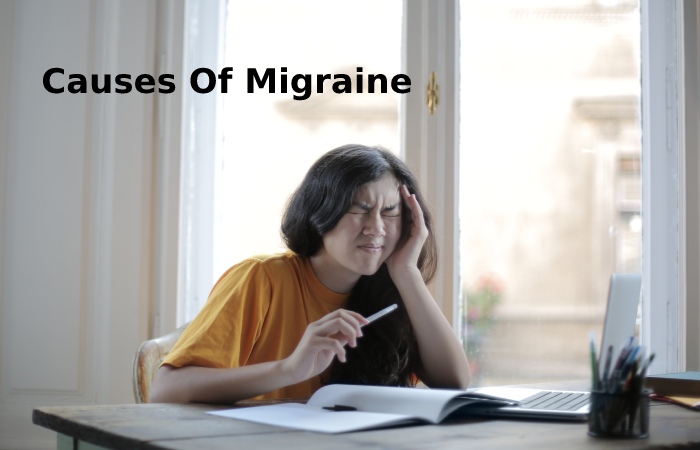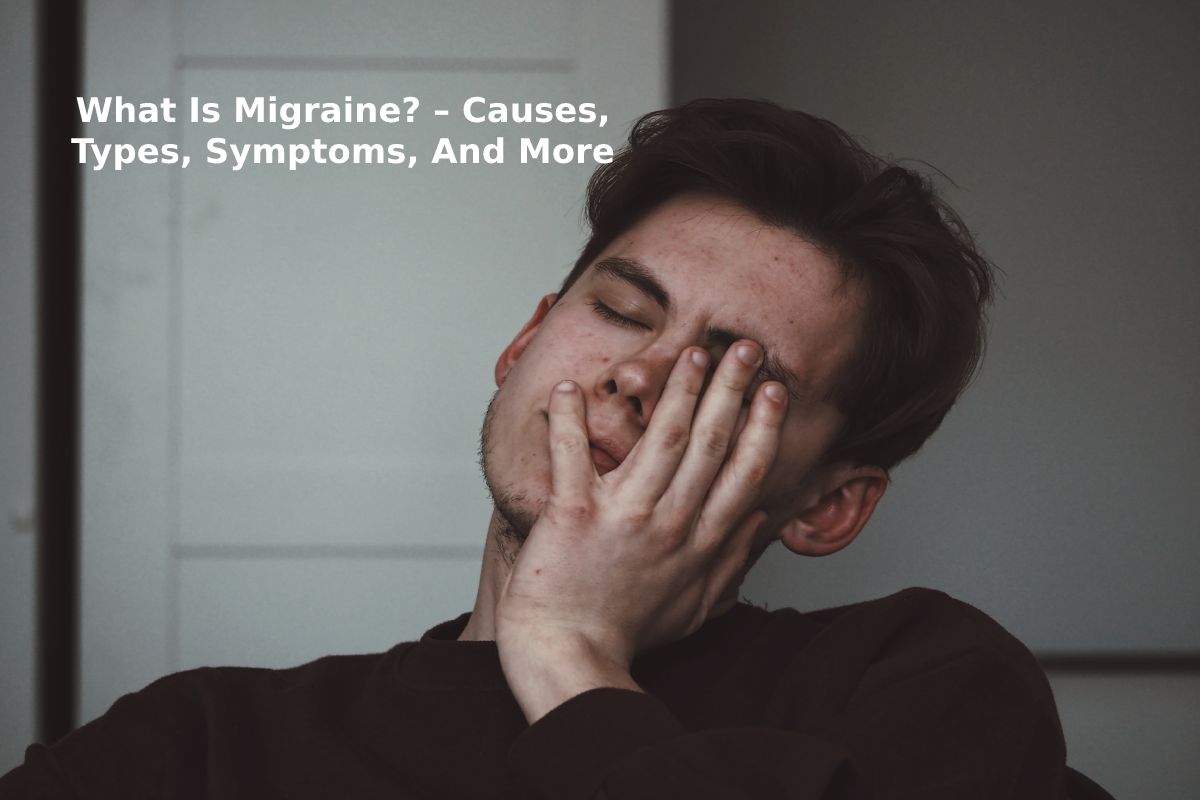Table of Contents
Introduction
A migraine is a recurrent, throbbing, severe headache that usually moves one side of the head, although it can affect both. The pain begins quickly and may be preceded or accompanied by visual, neurological, or gastrointestinal symptoms.
Although migraines can start at any age, they usually begin in people between 10 and 30. Sometimes it dissolves after 50 and is more common in women than in men. Seeing that more than 50 per cent of people with migraine have family members who also have it, one would assume that the tendency may be genetically transferred.
Aetiologia
We have a nerve located in brain called trigeminal nerve which will transfers sensation to head. these branches of nerves connect to the blood vessels of meninges, which is a tissue that covers brain. Sometimes, the meninges become inflamed, causing a sensation of pain transmitted to the brain through the trigeminal nerve and, therefore, causes a headache: a migraine.
Causes Of Migraine

The exact reasons for migraines are unknown, although several theories have been studies. Migraine is now believe to be a genetically-based constitutional disorder. The triggering reasons are difficult to identify and different in each person, but the most frequent are:
Inheritance: although the form of heritage is not fully established, in some particular forms of migraine, the gene that transmits it, located on chromosome 9, has already been identified.
Age: in childhood, migraine occurs equally in boys and girls. From puberty and due to hormonal changes, the incidence of migraine in women skyrockets.
Stress and anxiety: it is necessary to learn to relax, to look for some distraction in stressful moments.
Hormones: The more you suffer is about two or months mostly in spring and autumn and last for about period of time 4 to 72 hours. with the headache you may also witness other symptoms like vomiting, nausea and photophobia. To a lesser extent, they can cause irritability, anorexia, vertigo and dizziness. Migraine tends to worsen with ovulation and menstruation, as well as with taking oral contraceptives. Pregnancy, however, usually temporarily improves migraine, and many women improve dramatically when their periods stop ( menopause ).
Ingestion of alcohol and diet: some foods and drinks can favor a migraine attack to be triggered. For example, alcohol, especially red or burgundy wine; meals with monosodium glutamate (MSG); products containing tyramine (cheese); canned meats with nitrates; chocolate and artificial sweeteners.
Diet has an important relationship with the appearance of headaches and migraines. The type of food influences this aspect and the times the meals are produce. Thus, for example, fasting is one of the main reasons for migraine, so you should avoid prolonging the time without eating and maintain a regular meal schedule.
Lack of or excess sleep: can also be a migraine trigger.
Environmental factors: weather or temperature changes, glare or fluorescent lights, computer screens, strong odors, and high altitudes.
Migraine Carbonification
A migraine an occur again chronically if patient do not take measures to reduce its effects. On the opinion of Spanish Society of Neurology (SEN), there is about 3% of people suffering from migraine go from having an episodic migraine to a chronic one each year, while 6% go from a low-frequency migraine to a high-frequency one. Some of the causes that can cause this carbonification are the following:
- Self-medication.
- Excessive consumption of painkillers.
- Lack of diagnosis and treatment.
- Overweight and obesity .
- Sleep-disordered breathing, such as sleep apnea .
- Depression, stress and anxiety.
Symptoms
There is no helpful laboratory test for the diagnosis of migraine, although, due to its specific pattern of pain, it is often easy to identify. About 20 per cent of people experience symptoms of depression, irritability, restlessness, nausea, or lack of appetite, which appear 10 to 30 minutes before the onset of the headache (a period called the aura or prodrome).
The Periods Of A Migraine Attack Can Be Classified As Follows:
- Premonitory symptoms (prodrome)
Specific symptoms can be detected that could be related to a malfunction of the hypothalamus , a region of the brain that controls the body’s internal balance. These signs are tiredness, difficulty concentrating, increased appetite, yawning, and excessive fluid retention. These symptoms appear in 60 per cent of patients. They perform between two hours and two days before the pain begins.
- Aura
Not all migraines have an aura. They are transient neurological symptoms, which are established progressively and cause alterations in vision in most cases and, to a lesser extent, sensitivity or language. The aura only occurs in 15 to 20% of migraine patients and lasts between 10 and 30 minutes. It is due to a propagated cortical depression: the brain’s occipital lobe launches a wave that is emitted from the back to the front, causing a dysfunction in the brain structures.
The Most Common Types of Aura are:
Visual aura is the most common, appearing in 90% of migraines with atmosphere. Its form tends to be that of a flash in the center of the field of vision that spreads in the form of zigzag lines that move to one side. There are also different types of vision disturbance:
- Negative forms: the visual field is affected at certain points.
- Positive forms : false images appear, with flashes or distortions.
- Complex shapes alter vision by changing the color or size of objects in the visual field.
Sensitive aura: appears in 60% of cases. It consists of a tingling sensation that occurs in the fingers of the hand and spreads to the shoulders and, sometimes, to the mouth and tongue.
Aura of language: it is rare. The person who suffers from this aura has problems articulating words or understanding others.
Retinal aura: it is infrequent. Its signs are the same as those of the visual aura, but it affects only one eye.
Aura of the brainstem: it is scarce. Symptoms appear in the brainstem and are familiar to visual, sensory, and speech auras.
Motor aura: very rare. It produces a temporary paralysis of part or all of the body, although it usually does not last more than a day.
- Pain phase
The kind of pain and its affected area varies in each patient. It commonly presents as mild headache anxiety that rises in intensity. It lasts between four and 72 hours, while only a sixth of patients suffer from it for more than 48 hours.
- Resolution or “hangover” phase (postdrome)
The pain began by migraine is disappearing, although 80 per cent of those affected say they feel inadequate after the episode of intense pain. Its duration is variable: from a few hours to several days.
Prevention
Since the exact causes of a migraine are not clear, it is difficult to determine how to prevent it. However, you can follow some recommendations related to some of the frequent symptoms of patients suffering from migraine so that the chances of it appearing are lower:
Diet: Some patients associate the intake of certain foods with a migraine episode. Therefore, it is vital to know what the trigger food is and avoid only the one that triggers it. Among the foods that act as a possible trigger are alcohol, Chinese food, smoked foods, chocolate, nuts, citrus fruits or caffeine. Fasting is also associated with the onset of migraines, so it is vital to eat several times throughout the day at regular times.
Sleep hygiene: maintaining healthy sleep habits, getting enough rest, and a consistent schedule can prevent a migraine episode.
Hormone level: especially indicated for women who suffer from migraine during menstrual cycles. Estrogen variations that can be cause by, for example, contraceptives can worsen migraine episodes.
Types of Migraines
Most of Patients Suffer From the Frequent Types of Migraine, Which are:
Tension headache: it is mild or moderate pain. It can be cause by stress, poor posture, fatigue or depression.
Cluster headache: It is more common in women. It is a pain on one side of the head that extends to the eye. It can occur in night and last for 15 minutes.
Migraines : It has a set of symptoms, like vomiting, nausea, headache, people become sensitive to light and noise. it is a disorder that ma also effect based on genetics. It has a pulsatile character and is accompanied by generalized malaise. The pain is usually localize in one part of the head or all of it. This pain usually worsens with physical activity and improves with rest.
Migraines with aura: Migraine with aura affects between 15% to 30% of people who suffer from this pathology and is distinguished from other types of migraine by the appearance of symptoms that can affect sight or touch and even the ability to speak.
Also Read: What Is Coconut Oil For In Hair? – Benefits, Uses, And More

